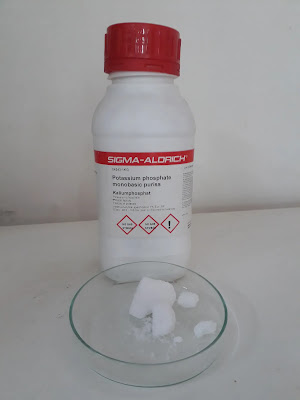Contents
hide
CHEMICAL PRODUCT IDENTIFICATION
- Product Name: Potassium Phosphate Monobasic
- Signal Sign: Warning!
- Access – Potassium Phosphate Monobasic SDS!
HAZARDS IDENTIFICATION
- According to the hazard’s classification, it can cause irritation, corrosion, & serious eye damage.
COMPOSITION, INFORMATION ON INGREDIENTS
- Component Name: Potassium phosphate monobasic.
- CAS # : 7778-77-0
- Formula: KH2PO4
- Formula(Molecular) Wt.: 136.09 g/mol.
- Percentage: 100%
- Synonyms: Potassium dihydrogen phosphate, Monopotassium phosphate.
FIRST-AID MEASURES
- If you feel unwell, contact a doctor.
- If inhaled: Remove the victim to fresh air & keep them at rest in a breathing-friendly position.
- If in the eyes: Carefully rinse for a few minutes with water. If contact lenses are present & simply possible to remove, do so. Rinsing continues.
- If on the skin: Thoroughly rinse with water.
- If skin irritation happens: consult the doctor or take medical advice.
- If Swallowed: Rinse mouth if swallowed. If you feel unwell, contact a doctor.
FIRE-FIGHTING MEASURES
- Flammability: It is not flammable.
- Appearance: Solid.
- produces dangerous gases when heated.
- Use a tri-class dry chemical fire extinguisher in the event of a fire.
ACCIDENTAL RELEASE MEASURES
- Ventilate the area
- .Put the spill in a sealed bag or container to dispose it of.
- After picking up the material wash the spill area.
HANDLING & STORAGE
- Store alongside phosphates, sulfates, sulfites, acetates, & halides.
- Store this in a chemical safety bag in a cool, dry place.
- Avoid eating, drinking, & smoking while taking this product.
EXPOSURE CONTROLS, PERSONAL PROTECTION
- Wear appropriate eye protection, gloves, & clothes.
- After handling, carefully wash your hands.
PHYSICAL & CHEMICAL PROPERTIES
- Appearance: It appears as colorless crystals or like white powder.
- Melting point: 253°C.
- Soluble: It is soluble in water & insoluble in alcohol(organic solvents).
- Specific gravity: 2.338.
- pH: 4.4 to 4.7 5% at 20°C.
STABILITY & REACTIVITY
- Keep away from powerful(strong) oxidizers.
- Weak & hygroscopic shelf life.
- Keep away from acids & bases(Strong).
- Avoiding Conditions: Exposing to moisture.
- Avoid the formation of dust.
TOXICOLOGICAL INFORMATION
- Acute effect: Irritating effects on the eyes.
- Effects over time(Chronic): N/A/
- Organs targeted: N/A.
- LD50 for ORL-RAT N/A.
- LC50 for IHL-RAT: N/A.
- LD50 for SKN-RBT: N/A.
ECOLOGICAL INFORMATION
- There are no ingredients in this chemical that are persistent, bioaccumulative, & toxic (PBT) or very persistent & very bioaccumulative (vPvB) at concentrations of 0.1% or more.
DISPOSAL CONSIDERATIONS
- Dispose of in accordance with local, state, & federal rules or laws.
TRANSPORT INFORMATION
- Name of shipment: Unrestricted. Risk category: N/A. UN identifier: N/A.
REGULATORY INFORMATION
- TSCA & EINECS listings (231-913-4).
OTHER INFORMATION
This Potassium Phosphate Monobasic SDS is intended as a piece of advice & is based on data & tests that are likely to be reliable. I don’t guarantee the data’s correctness or completeness & I’m not responsible for any resulting losses. The information is only being provided for your review, research, & verification. I DO NOT ASSUME RESPONSIBILITY AND EXPRESSLY DISCLAIM LIABILITY FOR LOSS, DAMAGE, OR EXPENSE RESULTING FROM OR IN ANY WAY CONNECTED WITH THE HANDLING, STORAGE, USE, OR DISPOSAL OF THIS PRODUCT FOR THE FOREGOING AND OTHER REASONS.

CONCLUSION
One must read Potassium Phosphate Monobasic SDS before performing any task. A good source of phosphorus & potassium is found in the specialized fertilizer monopotassium phosphate (MKP). It is a natural pH buffer with a buffer pH of 4.5 in clean water & is an acid, chloride-free, dry-soluble fertilizer. The dust may irritate the eyes, choking due to coughing, & inflammation of the respiratory tract may result from inhalation. The large doses may result in nausea, vomiting, pains in the stomach, & diarrhea. Wear appropriate eye protection, gloves, & clothes(PPE) & After handling, carefully wash your hands.
